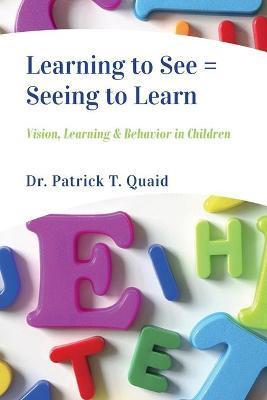Learning to See = Seeing to Learn: Vision, Learning & Behavior in Children

Learning to See = Seeing to Learn: Vision, Learning & Behavior in Children
Learning to See = Seeing to Learn: Vision, Learning & Behavior by Dr. Patrick Quaid et al, will unlock the connection between eyesight, education, and behaviors in children. How can you have 20/20 vision and not see well? Why are some very bright children unable to concentrate while reading and are unable to memorize what they see? This book will be especially interesting for teachers, educators, and parents with children who struggle to learn, are on an IEP, or who have been identified with ADD or ADHD. Learn about visual processing and why some children and adults struggle to see and understand what everyone else does naturally. Discover how challenges with visual processing can be corrected. This book will assist those in special education to add visual processing to the list of indications when assessing students with learning challenges. The important work of those supporting special education in the school system often leads to the development of an IEP for the student. As you will learn in the book, many IEPs may not be necessary if the root problem is one of visual processing. When ADD or ADHD is diagnosed, it often leads to many learning and behavior accommodations in the classroom. Many children then are given medications for ADHD and ADD to assist in behavior management. This diagnosis can change the trajectory of that child's life. This book encourages educators, parents, and physicians to pause before concluding that the student has ADHD or ADD. It may be that they have a visual processing problem. If that is the case, special education accommodations and medications will only mask the root problem. The agitation and difficulties concentrating may be due to their brain not correctly processing the information they see. Even getting glasses that give a child 20/20 vision does not solve the underlying problem. This book will help parents, teachers, and their healthcare professions recognize this common but often missed ingredient to a student's success in education and life. Below are some questions to consider. If this seems to describe your child or student, this book will help. A list of observations when a child has visual issues: -Taking far too long to copy information from the board to a page and vice versa. -Difficulty remembering how to spell and tending to spell the word how it sounds most of the time. -Losing their place often when reading, skipping lines, missing whole words or word endings, (using their finger or a ruler to trac
PRP: 96.88 Lei
Acesta este Pretul Recomandat de Producator. Pretul de vanzare al produsului este afisat mai jos.
87.19Lei
87.19Lei
96.88 LeiLivrare in 2-4 saptamani
Descrierea produsului
Learning to See = Seeing to Learn: Vision, Learning & Behavior by Dr. Patrick Quaid et al, will unlock the connection between eyesight, education, and behaviors in children. How can you have 20/20 vision and not see well? Why are some very bright children unable to concentrate while reading and are unable to memorize what they see? This book will be especially interesting for teachers, educators, and parents with children who struggle to learn, are on an IEP, or who have been identified with ADD or ADHD. Learn about visual processing and why some children and adults struggle to see and understand what everyone else does naturally. Discover how challenges with visual processing can be corrected. This book will assist those in special education to add visual processing to the list of indications when assessing students with learning challenges. The important work of those supporting special education in the school system often leads to the development of an IEP for the student. As you will learn in the book, many IEPs may not be necessary if the root problem is one of visual processing. When ADD or ADHD is diagnosed, it often leads to many learning and behavior accommodations in the classroom. Many children then are given medications for ADHD and ADD to assist in behavior management. This diagnosis can change the trajectory of that child's life. This book encourages educators, parents, and physicians to pause before concluding that the student has ADHD or ADD. It may be that they have a visual processing problem. If that is the case, special education accommodations and medications will only mask the root problem. The agitation and difficulties concentrating may be due to their brain not correctly processing the information they see. Even getting glasses that give a child 20/20 vision does not solve the underlying problem. This book will help parents, teachers, and their healthcare professions recognize this common but often missed ingredient to a student's success in education and life. Below are some questions to consider. If this seems to describe your child or student, this book will help. A list of observations when a child has visual issues: -Taking far too long to copy information from the board to a page and vice versa. -Difficulty remembering how to spell and tending to spell the word how it sounds most of the time. -Losing their place often when reading, skipping lines, missing whole words or word endings, (using their finger or a ruler to trac
Detaliile produsului











